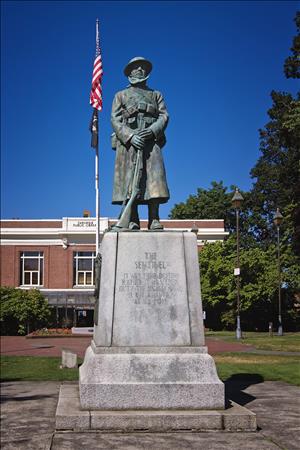On Armistice Day, November 11, 1924, a public dedication is held in Centralia for The Sentinel, a bronze 10-foot-tall statue by sculptor Alonzo Victor Lewis that depicts an American soldier on guard duty. The artwork is a memorial to four U.S. army veterans slain five years earlier in a confrontation with members of the Industrial Workers of the World (IWW).
The Confrontation
On November 11, 1919, a gun battle broke out between marching American Legionnaires and members of the Industrial Workers of the World (IWW) during an Armistice Day parade in Centralia. Four Legionnaires (all World War I veterans) were killed and a number of Wobblies arrested, one of whom was taken from the city jail that night and lynched from a bridge over the Chehalis River. The event became known as the Centralia Massacre, and was also called the Armistice Day Riot and the Armistice Day Tragedy.
In the wake of the confrontation, Centralia city officials described the killings as a "diabolical plot" ("Reds Directly Accused by City"). IWW members insisted that they had been attacked and had acted in self-defense. Seven union members were later convicted of second-degree murder in a trial in Montesano.
Alonzo Victor Lewis
In 1922 sculptor Alonzo Victor Lewis (1886-1946) was completing a clay model for a monumental-sized statue of a World War I soldier, titled Doughboy, intended as a public war memorial in Seattle. In that same year, he was approached by a group that included members of the memorial committee of American Legion Rhodes Post No. 2 in Tacoma, headed by C. D. Cunningham. Called the Centralia Memorial Association, its goal was to fund the creation of a 10-foot-tall statue in bronze, named The Sentinel, as a memorial to the four veterans killed in Centralia two three years earlier.
Lewis was approached only after the group ran into trouble securing funds through statewide veterans' groups, notably American Legion posts. Up to a quarter-million dollars was the initial target, but efforts fell far short of the mark, with only $16,000 collected. Faced with the need for a low-cost solution, the group turned to Lewis after learning of his work on Doughboy, which demonstrated his expertise in the portrayal of military figures.
The Sentinel
Lewis's design for the The Sentinel was similar in some ways to his Doughboy (the same helmet and rifle are seen in both, and both are oversized figures, cast in bronze), but it was significantly different in other respects. The Doughboy figure is in motion, striding forward, while the figure of the soldier in the Centralia memorial is standing stoically on guard duty, his rifle clasped between his hands and the bayonet folded on the stock. The soldier depicted in the Doughboy statue is smiling, while The Sentinel has a serious mien, with the collar of his uniform trench coat turned up against the elements.
An engraving on front of the stone base of The Sentinel states "IT WAS THEIR DESTINY - RATHER IT WAS THEIR DUTY - THE HIGHEST OF US IS BUT A SENTRY AT HIS POST." On the back side of the base is an engraved tribute to the four dead Legionnaires. It does not mention the IWW; the memorial committee believed that "would be an open invitation for a dynamiting" (McClelland, 192). But it does say the men died while "on peaceful parade," a characterization that has been disputed. There also are bronze bas-relief portraits of the dead, two on each side of the base.
The Sentinel was installed and dedicated on Armistice Day, November 11, 1924, in Centralia's George Washington Park, and was placed on the National Register of Historic Places on December 17, 1991. A century later, disputes surrounding the facts of the Centralia Massacre and the memorial to it continued to be a source of local controversy. A committee was formed to commission a new monument near the existing statue that would reflect the IWW's version of events. In the months leading up to the 100th anniversary of the tragedy, disagreements over the proposed language led to a postponement of those plans.

